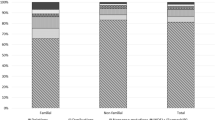Abstract
Background: Approximately one-third of new cases of Duchenne muscular dystrophy (DMD) can be attributed to sporadically arising new mutations, however in the majority of cases the DMD mutation has been inherited from the mother. These female carriers can have either a constitutive or mosaic mutation.
Aim: The aim of this study was to determine the segregation of the at-risk haplotype and to find a deletion in the dystrophin gene of patients.
Method: We analyzed individuals from two families with a history of DMD in order to predict the carrier status of related females. In one of these cases the mother had two affected sons, while in the other one son and two grandchildren were affected; therefore we predict that the mother would be an obligatory carrier.
Results: Haplotype analysis of the DMD loci revealed that in the two families both the healthy and affected brothers had inherited the same X maternal chromosome. However, the affected brother carried a deletion, which was absent in the unaffected sibling.
Conclusion: These findings suggested that the mothers in the two families were germline mosaics for the DMD gene. The results of this study demonstrate the usefulness of the methodology that combine the haplotype analysis with the identification of the mutation in order to detect hidden germline mosaicisms and, thus, improve genetic counseling.






Similar content being viewed by others
References
Emery AEH. Duchenne and other X-linked muscular dystrophies. In: Rimoin D, Connor JM, Pyeritz RE, editors. Principle and practice of medical genetics. Edinburgh: Churchill Livingstone, 1996: 2337–54
Den Dunnen JT, Grootsholten PM, Bakker E, et al. Topography of the DMD gene: FIGE and cDNA analysis of cases reveals 115 deletions and 13 duplications. Am J Hum Genet 1989; 45: 835–47
Koenig M, Beggs AH, Moyer M, et al. The molecular bases of Duchenne versus Becker muscular dystrophy: correlation of severity with type of deletion. Am J Hum Genet 1989; 45: 498–506
Edwards JH. The population genetics of Duchenne: natural and artificial selection in DMD. J Med Genet 1986; 23: 521–30
Barbujani G, Russo A, Danielli GA, et al. Segregation analysis of 1885 families: significant departure from the expected proportion of sporadic cases. Hum Genet 1990; 84: 522–6
Essen AJ, Mulder IM, van der Vlies P, et al. Detection of point mutation in dystrophin gene reveals somatic and germline mosaicism in the mother of a patient with Duchenne muscular dystrophy. Am J Med Genet 2003 Apr 30; 118A(3): 296–8
Chaturvedi LS, Mittal RD, Srivastava S, et al. Analysis of dinucleotide repeat loci of dystrophin gene for carrier detection, germline mosaicism and de novo mutations in Duchenne muscular dystrophy. Clin Genet 2000; 58(3): 234–6
Darras BT, Francke U. A partial deletion of the muscular dystrophy gene transmitted twice by an unaffected male. Nature 1987; 329: 556–8
Abbs S, Yau SC, Clark S, et al. A convenient multiplex PCR system for the detection of dystrophin gene deletions: a comparative analysis with cDNA hybridization shows mistypings with both methods. J Med Genet 1991; 28: 304–11
Oudet C, Heiling R, Mandel JL. An informative polymorphism detectable by polymerase chain reaction at the 3′end of the dystrophin gene. Hum Genet 1990; 84: 283–5
Feener CA, Boyce FM, Kunkel LM. Rapid detection of CA polymorphisms in cloned DNA: application to the 5′ region of the dystrophin gene. Am J Hum Genet 1991; 48: 621–7
Beggs AH, Kunkel LM. A polymorphic CACA repeat in the 3′untranslated region of dystrophin. Nucleic Acids Res 1990 Apr 11; 18(7): 1931
Miller M, Boehm C, Cotton M, et al. Usefulness of a CACA repeat polymorphism in genotype assignments in Duchenne/Becker muscular dystrophy. Am J Med Genet 1992; 44: 473–6
Clemens PR, Fenwik RG, Chamberlain JS, et al. Carrier detection and prenatal diagnosis in duchenne and Becker muscular dystrophy families, using dinuceotide repeat polymorphism. Am J Hum Genet 1991; 49: 951–60
Murray MG, Thompson WF. Rapid isolation of high-molecular-weight plant DNA. Nucleic Acids Res 1980; 8: 4321–5
Chamberlain JS, Gibbs RA, Ranier JE, et al. Multiplex PCR for the diagnosis of Duchenne muscular dystrophy. In: Innes MA, Gelfand DH, Sninski JJ, et al., editors. PCR protocols. San Diego (FL): Academic Press, 1990: 272–81
Beggs AH, Koenig M, Boyce FM, et al. Detection of 98% of DMD BMD gene deletions by polymerase chain reaction. Hum Genet 1990; 86: 45–8
Leiden Muscular Dystrophy pages. Center for Human and Clinical Genetics, Leiden University Medical Center, 2003 [online]. Available from URL: http://www.dmd.nl/ [Accessed 2003 Dec 1]
Bakker E, Veenema H, Den Dunnen JT, et al. Germinal mosaicism increases the reccurrence risk for “new” Duchenne muscular dystrophy mutations. J Med Genet 1989; 26: 553–9
Acknowledgements
The authors are grateful to the patients and families for their collaboration. We wish to thank Sabina Domené for language supervision, and Ezequiel Surace and Viviana Dalamón for their invaluable contribution.
This work was supported by grants from the Universidad de Buenos Aires (BO69) and Agencia de Promoción Científica y Técnológica (PICT 5-8684).
The authors have provided no information on conflicts of interest directly relevant to the content of this study.
Author information
Authors and Affiliations
Corresponding author
Rights and permissions
About this article
Cite this article
Ferreiro, V., Szijan, I. & Giliberto, F. Detection of germline mosaicism in two duchenne muscular dystrophy families using polymorphic dinucleotide (CA)n repeat loci within the dystrophin gene. CNS Drugs 8, 115–121 (2004). https://doi.org/10.1007/BF03260054
Published:
Issue Date:
DOI: https://doi.org/10.1007/BF03260054




